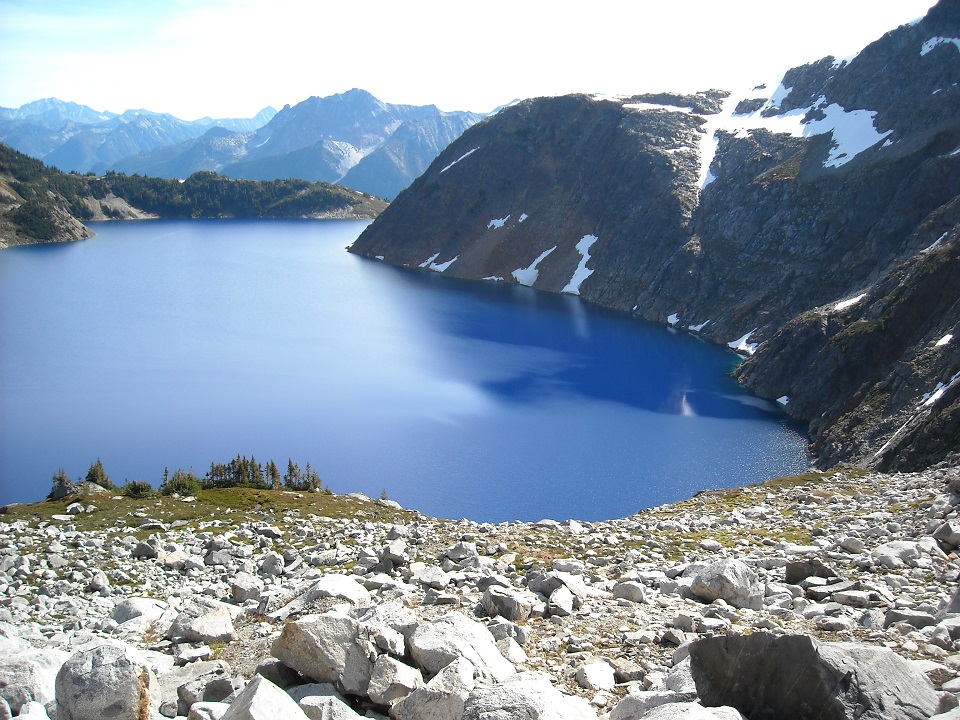Knowledge and Reality
I was crossing a steep slope high in the mountains. It was a warm, sunny day in mid-September. To my left, high above, a jagged ridge was silhouetted against the blue sky. To my right, far below, a deep blue alpine lake sparkled in the sunlight. The slope between them was a mosaic of boulder fields and cliffs, with a few patches of krummholz and heather clinging to the rocks. Sweat was trickling down my forehead and into the corners of my eyes, making them sting. I licked my lips and tasted salt and rock dust.
At a conveniently shaped boulder, I stopped to rest and have a drink of water. I took my backpack off. The air felt cool on my sweaty back and shoulders. I gulped water from my bottle. I wiped the sweat from my face with my sleeve. Then I sat on the boulder and gazed at the landscape. The ridge across the lake had almost no vegetation, just gray rock and white snowfields. To the east, I could see range after range of mountains, fading away into the distance. Below, the lake sparkled in the sunlight. It was a deep royal blue.
As I sat there, absorbing the view, a rock fell from the cliffs and clattered down the slope. I tensed — and then relaxed when I saw that it wasn’t heading toward me. It bounded down the slope in huge leaps, raising little puffs of dust when it hit other rocks. It went over a cliff, and I lost sight of it, but I could still hear it bouncing down the slope until it stopped somewhere far below. All day, rocks had been falling from the cliffs above me. It was making me a bit nervous.
For some reason, that rock started a cascade of thought. I had a sudden insight about knowledge.
Ideas are just the connections between experiences.
The idea of the rock is just a way to connect many little experiences. My experience of the rock consisted of disconnected images of the rock itself and puffs of dust, plus the sounds it made. It began with the sounds, which alerted me to presence of a falling rock. I looked for it, saw some visual images of a rock and puffs of dust, and connected those experiences into the idea of a rock falling down the slope. My brain integrated many different sensory impressions into a single idea.
I picked up a rock and held it in my hand, turning it over and over. It felt dry, dusty and rough. I knew that I was experiencing the idea of the rock, not the rock itself. The rock itself was out there, but my experience of the rock was in my brain. Perceptions are ideas. So are actions. My brain was generating the idea of turning the rock over and over. Information from that idea was causing motor neurons to fire, muscles to tense and relax, and the rock to turn over in my hand. Information and causality were flowing from the rock to my brain and back, through my senses and muscles.
Ideas are used to organize that flow of information and causality. The idea of the rock connects the image on my retina to the feeling in my hand, and the feeling in my hand to the movement of my muscles. When I move the rock, the feeling in my hand changes, and so does the visual image. The idea is used to generate the motion of my hand that moves the rock. The idea predicts the effect of muscular contractions. If I look away, the idea of the rock explains why the image changes. When I look back, it explains why I see the same thing that I saw a moment before.
I tossed the rock downslope. It clattered across the boulders, fell into a crack and disappeared.
I picked up another rock and held it in my hand.
What makes this a rock? Why do I use the same concept to represent this thing, that thing I just threw, and the thing I saw bouncing down the slope a few minutes ago? Because I interact with them in similar ways. They affect my senses in similar ways, and I can act on them in similar ways. The rock in my hand now is similar to the one I was just holding a few seconds ago. It creates a similar image on my retina. It creates a similar feeling in my hand. It requires a similar amount of muscular tension to hold.
Knowledge is abstracted from experience and stored in concepts, such as “rock”. Stored concepts are then used to create ideas. The lake below is a “lake” because I recognize the current visual image as an instance of the concept “lake”. This rock in my hand is a “rock” because it fits the concept of “rock”. It interacts with my sensory and motor systems in roughly the same way as other rocks. Seeing one rock is similar to seeing another. Picking up one rock is similar to picking up another. Throwing one rock is similar to throwing another. My brain abstracted the concept “rock” from past experience. It is now using that concept to interpret sensory experience and generate action.
I let go of the rock. It bounced a few times, and then fell into a crack between the boulders. I took another drink, gazing at the lake below.
For a long time, I had been thinking about the nature of knowledge. Now, out of the blue, a theory of knowledge was crystallizing in my brain. Disorder was collapsing into order. Confusion was collapsing into clarity.
After a few minutes of quiet contemplation, I put on my backpack and continued working my way across the slope.

Comments
Post a Comment